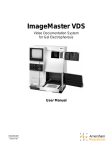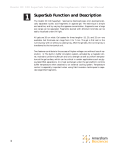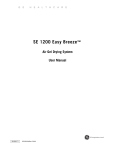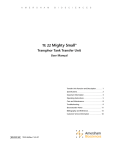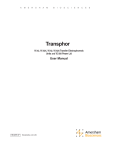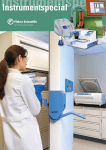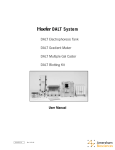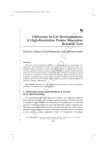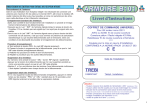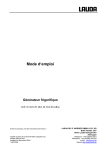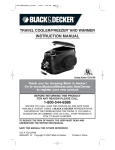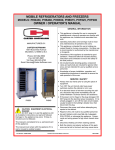Download HE 33 Mini Submarine Electrophoresis Unit User Manual
Transcript
HE 33 Mini Submarine Electrophoresis Unit User Manual 80-6273-42 HE33-IM/Rev. E1/7-99 HE 33 M i n i Submarine Electrophoresis Unit Mini Submarine Electrophoresis Unit Function . . 1 Important Information . . . . . . . . . . . . . 2 Unpacking . . . . . . . . . . . . . . . . . 3 Specifications . . . . . . . . . . . . . . . . 3 Operating Instructions . . . . . . . . . . . . 4 Care and Maintenance . . . . . . . . . . . . 9 Troubleshooting . . . . . . . . . . . . . . . 10 Notes, Buffers, and Volumes . . . . . . . . . 11 Bibliography . . . . . . . . . . . . . . . . 15 Customer Service Information . . . . . . . . . 16 A m e r s h a m B i o s c i e n c e s HE 33 M i n i Submarine Electrophoresis Unit Mini Submarine Electrophoresis Unit Function The HE 33 horizontal agarose unit is intended for rapid electrophoresis of small quantities of nucleic acids in agarose gels. A gel is cast in the gel caster, which holds one or two combs. (Eight different combs are available; a maximum of 32 samples can be run if two 16-well combs are used.) After the gel sets, the running tray is transferred to the platform of the horizontal unit. The base of the unit holds coolant that can be chilled before the run. This passive cooling capacity allows fast, high voltage runs. Color-coded leads connect electrodes in the unit base to the power supply. Figure 1. Main components (See Figure 2 for an illustration of the casting kit.) Buffer chamber Lid assembly Electrode connectors (2) Running platform (supports the running tray) Fill the base with 50/50 ethylene glycol/ water A m e r s h a m B i o s c i e n c e s 1 HE 33 M i n i Submarine Electrophoresis Unit Important Information Informations importantes ➧ ➧ ➧ ➧ ➧ ➧ ➧ ➧ ➧ 2 The safety lid must be in place before connecting the power leads to a power supply. Turn all power supply controls off and disconnect the power leads before removing the safety lid. ➧ Before the first use, fill the base with about 600 ml 50/50 ethylene glycol/water to prevent irreparable damage to the unit. (See instructions on page 4.) The base must be filled even if no cooling is required. ➧ Do not use pure water, commercial anti-freeze, or any organic solvent to fill the base. Water expands as it freezes. Because the water is trapped in the base, it may crack. Organic solvents will cause irreparable chemical damage to the unit! ➧ Do not chill the base below -20 °C (-4 °F). Chill the base in a bucket of ice, refrigerator, or in a freezer. Do not operate with gel or buffer temperature above 50 °C. Prevent overheating by chilling the base prior to use. To prevent overheating during prolonged high-voltage runs, exchange the first base with an extra prechilled second base if one is available. Overheating will cause irreparable damage to the unit! ➧ ➧ If this equipment is used in a manner not specified by the manufacturer, the protection provided by the equipment may be impaired. ➧ Only accessories and parts approved or supplied by Amersham Biosciences may be used for operating, maintaining, and servicing this product. ➧ A m e r s h a m Le couvercle de sécurité doit être en place avant de brancher les prises au générateur. Eteindre le générateur et débrancher les prises avant d’enlever le couvercle de sécurité. Avant la premiére utilisation, remplir le socle avec environ 600 ml 50/50 d’éthylène glycol et d’eau afin de ne pas endommager l’instrument. (Voir page 4 du mode d’emploi). Le socle doit être rempli même si le refroidissement n’est pas nécessaire. Ne pas utiliser seulement de l’eau, de l’antigel commercial ou tout autre solvant organique pour remplir le socle. L’eau augmente en volume lorsqu’elle gêle. Du fait que l’eau est enfermée, le socle peut se fendre. Les solvants organiques peuvent causer des dommages chimiques irréparables. Ne pas refroidir le socle en dessous de -20 °C (-4 °F). Refroidir le socle dans un seau rempli de glace ou un dans un réfrigérateur. Ne pas utiliser avec un gel ou un tampon à plus de 50 °C. Eviter le surchauffement en refroidissant le socle avant l’emploi. Afin d’éviter le surchauffement durant de longues utilisations sous haut voltage, échanger si possible, le socle avec un second socle déjà refroidi.Un surchauffement peut causer des dommages irréparables à l’instrument. Si l'instrument n'est pas utilisé en conformité avec les recommandations du fabriquant, les protections de sécurité qui équipent cet appareil peuvent être rendues inéfficaces. Seulement les accessoires et piéces detachées approuvés ou fournis par Amersham Biosciences sont recommandés pour l’utilisation, l’entretien et réparation de cet appareil. B i o s c i e n c e s HE 33 M i n i Submarine Electrophoresis Unit Unpacking Unwrap all packages carefully and compare contents with the packing list, making sure all items arrived. If any part is missing, contact your local sales office. Inspect all components for damage that may have occurred while the unit was in transit. If any part appears damaged, contact the carrier immediately. Be sure to keep all packing material for damage claims or for repacking should it become necessary to return the unit. Specifications Max. voltage 500 V for 5 minutes or less Max. wattage 15 W Max. current 500 mA Max. operating temperature 50 °C Max. buffer volume 250 ml Coolant required ≈600 ml 50/50 water/ethylene glycol Gel size Environmental operating conditions 7 × 10 cm Indoor use: 4–40 °C Humidity up to 80% Altitude up to 2000 m Installation category II Pollution degree 2 Dimensions width × depth × height 24×13×7 cm (9.5×5.2×2.8 in.) Weight (base, lid, and leads only) Product certifications 0.4 kg (0.9 lbs) EN61010–1, UL3101–1, CSA C22.2 1010.1, CE This declaration of conformity is only valid for the instrument when it is: ◗ used in laboratory locations, ◗ used as delivered from Amersham Biosciences except for alterations described in the User Manual, and ◗ connected to other CE labeled instruments or products recommended or approved by Amersham Biosciences. A m e r s h a m B i o s c i e n c e s 3 HE 33 M i n i Submarine Electrophoresis Unit Operating Instructions Agarose gels are first prepared using the gel casting kit. Samples are then loaded into wells and electrophoretically separated. The fluorescent dye ethidium bromide can be added to the gel or electrophoresis buffer or both to track separation progress. After electrophoresis, the gel may be stained and photographed, blotted, or dried for autoradiography. Fill the base with coolant Important Do not fill the base with commercial antifreeze, organic solvents, or pure water. Even if no cooling is required, it is important to fill the base with the proper coolant solution before the first use because the solution provides a necessary heat sink. 1 Prepare 600 ml of 50/50 ethylene glycol/water. Optional: To help see wells better while loading the sample, add a drop or two of soluble dye or food color to the coolant solution. Locate the inlet hole on the bottom of the base, near the edge. Fill the base cavity as full as possible with coolant using a 50-ml syringe or pump. 2 Fit the threaded, white plastic plug into the hole and, taking care that the thread is properly engaged, screw it in place until it is snug. Tighten another 1/8 to 1/4 turn to prevent leaks. 3 Place the prepared base in an ice bucket or into a refrigerator or freezer set no lower than -20 °C for about an hour before use. (The base will always be ready if you store it in the refrigerator or freezer.) Note It is not necessary to replace the coolant. 4 A m e r s h a m B i o s c i e n c e s HE 33 M i n i Submarine Electrophoresis Unit Prepare solutions 1 Prepare 250 ml of running buffer. (Refer to p. 13 for recipes of commonly used electrophoretic running buffers.) 2 Prepare the sample loading buffer. (Refer to p. 14 for a recipe and a table of volume requirements for each comb size.) 3 Prepare approximately 7 ml agarose solution per mm of gel thickness. (For example, a 3-mm gel requires 0.3 cm x 7 cm x 10 cm = 21 ml) Caution Dissolve agarose in running buffer, heat according to instructions accompanying the agarose, and allow the solution to cool to 50 °C before pouring into the casting tray. Ethidium bromide is a known mutagen. Always wear gloves when handling. Optional: Add 0.5 µg/ml ethidium bromide to the gel solution to observe separation during electrophoresis. Cast the gel 1 Install the running tray. Firmly grasp the casting tray with one hand. With the other hand, place one end of the running tray against the foam pad at the bottom edge, press the tray against the pad, and then lower it to rest on the bottom of the casting tray, seating the other end of the tray against the opposite foam pad. Figure 2. Gel casting kit Approach the foam pad with one end of the running tray and then gently press the tray edge against the pad, compressing it enough to allow the opposite end of the running tray to drop fully into the casting tray before sealing against the foam pad. UV-transparent running tray (Cast the gel on this tray, then transfer gel to the horizontal unit base for electrophoresis.) Foam pads (2) A m e r s h a m B i o s c i e n c e s Gel casting tray 5 HE 33 M i n i Submarine 2 Electrophoresis Unit Prepare the comb(s). Fit the two slots in the comb between the (loosened) thumb screw heads and the comb back. Tighten the screws until the comb is just supported. Seat the comb assembly on the rim of the casting tray and adjust the bottom of the comb so that it is about 1.0 mm from the running tray. Tighten the screws to secure the comb. To run twice as many samples, prepare two combs. Figure 3. A comb back, which fits onto the rim of the casting tray, positions the comb in the gel. Two screws hold the adjustable comb. For twice as many wells, a second comb can be placed in the center of the gel. Comb back 6 Screws (2) Comb 3 Remove the comb assembly. Place the casting assembly on a leveling surface and level, using the spirit level on the running tray as a guide. 4 Pour the agarose solution (cooled to 50 °C) into the casting tray. Orient the comb assembly so that the comb faces the nearest foam pad and seat it on the tray rim. Check that the comb is vertical to prevent well shape distortions. To run twice as many samples, place the second comb assembly in the center of the tray. Allow a minimum of 30 minutes for the gel to set. 5 Once the gel is set, remove the comb carefully. Partially lift and slightly tilt the comb at one end and then slowly withdraw it from the gel. (Pulling the comb straight up creates a vacuum in the wells that may lift the gel out of the tray.) 6 Remove the running tray and gel by grasping the handles of the tray and pressing against one of the foam pads. Once the tray clears the opposite pad, lift it out. Transfer the running tray and gel to the chilled base. A m e r s h a m B i o s c i e n c e s HE 33 M i n i Submarine Electrophoresis Unit The electrophoresis run Refer to the Notes, Buffers, and Volumes section for additional information and guidelines. 1 Caution Chill the base before use, especially when higher voltage settings will be used or when the separation will require more than 30 minutes. Note: To monitor separation progress, either add 0.5 µg/ml (final conc.) of ethidium bromide to the running buffer now, or, add 50 µg/ml (final conc.) ethidium bromide to the sample buffer. To visualize progress, turn off the power supply, remove the lid assembly, and hold a portable UV lamp near the gel. Ethidium bromide is a known mutagen. Always wear gloves when handling. Wear UV safety goggles and protect skin when using a UV lamp. Adding ethidium bromide to the running or sample buffer slows migration slightly. Detection by this method is not as sensitive as staining and viewing on a transilluminator. (See DNA detection, p. 15.) 2 Fill both buffer chambers with running buffer until the gel is submerged under ≈1 mm of solution. (This requires about 220 ml.) Note 3 If no dye was added to the coolant, place the base on a dark background to see the wells more easily. Load the samples. Add sample to 5X sample loading buffer and mix (1/5 of the final volume is loading buffer, see p. 14). Use a micro-pipette to load each sample, taking care to avoid puncturing the well bottom or entrapping any bubbles. 4 Place the lid so that the cathode (–, black lead) is at the end nearest the sample well. (Nucleic acid samples migrate toward the anode, +, red lead.) Connect the color-coded leads (red to red, and black to black) to an approved power supply, such as the EPS 2A200. Set the voltage level and timer (if available) according to the degree of resolution sought. A m e r s h a m B i o s c i e n c e s 7 HE 33 M i n i Submarine Electrophoresis Unit Quick, high-voltage runs Certain applications, such as screening samples or checking sample purity, can be accomplished quickly under high voltage conditions. Chill the base (-20 °C) and limit the run to 5 minutes or less at 500 V. Note: At the maximum setting the unit begins overheating as soon as the chilled base reaches ambient temperature. If overheating is not controlled, the gel will melt and/or the base of the unit will warp! Note To calculate the voltage gradient, divide the voltage setting by the distance between the electrodes (12.7 cm). Slower, lower voltage runs A voltage gradient of 12 V/cm (150 V) separates 0.1 to 23 kb fragments of a Hind III digest of l DNA in 30 to 40 minutes (using 1% agarose gel and 0.5X TBE running buffer). Alternatively, using the same solutions, this sample could also be run at 24 V/cm (300 V) with acceptable band resolution in 20 to 30 minutes. Chill the base before use. Table 1 Voltage settings and the maximum recommended separation time, using 1% Agarose NA agarose, 0.5X TBE, and a chilled base. Voltage (V) Gradient (V/cm) Time (min) 500 400 300 200 150 40 31 24 16 12 5* 10* 20* 30 to 40 30 to 60 *For rapid runs of 20 minutes or less, use 0.5X TBE and chill the base to -20 °C before use. 8 A m e r s h a m B i o s c i e n c e s HE 33 M i n i Submarine Electrophoresis Unit After the separation 1 Turn off the power supply, disconnect the leads, and remove the lid. 2 If no ethidium bromide was added to the gel or sample before the run, stain the gel in a solution of 0.5 to 1.0 µg/ml ethidium bromide in water or buffer. 3 Clean the unit as described below. Care and Maintenance Cleaning Important: Never autoclave any component of the electrophoresis unit or casting kit. After each use, clean the unit with a mild detergent and water, rinse thoroughly with distilled water, and allow to air dry. Never use abrasive cleansers. Do not expose the unit to solutions or vapors of aromatic or halogenated hydrocarbons, ketones, esters, alcohols (over 30%), or concentrated acids (over 25%). To reduce DNase and RNase contamination, soak the buffer chamber or casting kit for 10 minutes in a 3% hydrogen peroxide (H2O2) solution, then rinse thoroughly with DEPC-treated, autoclaved, deionized water. (Sambrook, et al. 1:7:40) Replacing foam pads Remove worn foam pads. Peel off the adhesive cover on a new foam pad. Align the pad so that it will rest on the bottom of the tray along a short (7-cm) side, adhesive side toward the inside wall, and then press it in place. Repeat with second pad on the wall opposite the first pad. Replacing the electrode It is recommended that electrodes be replaced only by Amersham technicians. Call your local representative for advice. Amersham Biosciences 9 HE 33 M i n i Submarine Electrophoresis Unit Troubleshooting Deformed sample well ✓ Allow the gel to set for a minimum of 30 minutes and make sure it is at room temperature before removing the comb. ✓ When removing the comb, hold it at a slight angle and lift very slowly to prevent the gel from breaking. ✓ Take care to not damage the well with the pipet while loading the sample; aim for the center of the well and do not puncture the bottom with the pipet tip. Samples not running along a straight path ✓ If a comb or running tray is warped, replace. ✓ Reduce the voltage. ✓ Choose a buffer with the appropriate ionic strength and buffering capacity. (The buffering capacity of TBE, for example, is higher than that of TAE.) If the buffer is depleted, stop the run, remove the lid, and pipette the buffer from each chamber into the opposite chamber to replenish the buffer. ✓ If the gel is uneven, level the casting tray before pouring the gel. Double-banded pattern ✓ The comb must be vertical to prevent well shape distortion. ✓ Decrease the buffer level to 1 mm above the top of the gel, to reduce the vertical temperature gradient. Poor band resolution ✓ Add Ficoll, glycerol, or sucrose to the sample loading buffer to ensure that the sample sinks to the bottom of the well. (Ficoll is preferred.) ✓ Make sure the sample is completely dissolved. ✓ Reduce the voltage. ✓ Reduce the sample concentration. ✓ Reduce the sample volume. ✓ At least 1 mm of gel below the bottom of the comb is required to prevent samples from leaking out of the well bottom. ✓ Reduce the salt concentration of the sample. ✓ Check enzyme activity; the sample may require longer digestion or a different restriction buffer. ✓ Prepare fresh sample if you suspect nuclease contamination. ✓ Choose agarose with a low endosmosis value. ✓ Install the running tray as as described on page 4; do not press straight down into place. Foam pads peel off 10 A m e r s h a m B i o s c i e n c e s HE 33 M i n i Submarine Electrophoresis Unit Notes, Buffers, and Volumes Agarose gel electrophoresis notes Agarose gel electrophoresis can be used to separate DNA fragments as small as 0.1 kb or less. Polyacrylamide gels are usually used for fragments smaller than 1 kb. DNA mobility Suggested agarose concentration for separating fragments of various sizes is given in Table 2 below. Other factors affecting separation results include the running buffer, voltage setting, temperature, conformation, and the presence of ethidium bromide. Special agaroses are available that can extend resolution ranges. A common standard is a Hind III digest of lambda phage, which gives eight fragments ranging in size from 0.1 to 23 kb pairs. For good resolution, run 45 minutes on a 10-cm long, 1% agarose gel in 0.5X TBE gel at 150 V. Table 2. Agarose concentrations for separating DNA fragments of various sizes Agarose (%) 0.5 0.7 1.0 1.2 1.5 Effective range of resolution of linear DNA fragments* (kb) 1.0 0.8 0.5 0.4 0.2 — — — — — 30 12 10 7 3 *Current Protocols in Molecular Biology, p 2.5.2 (1993) A m e r s h a m B i o s c i e n c e s 11 HE 33 M i n i Submarine Electrophoresis Unit RNA mobility RNA can also be separated on the basis of size. To avoid irregularities due to secondary structure, RNA is denatured either before or during electrophoresis. For example, RNA fragments previously denatured with glyoxal and dimethylsulfoxide can be separated on neutral agarose gels, or RNA can be fractionated on agarose gels containing methylmercuric hydroxide or formaldehyde. RNA samples usually require longer runs or buffers that are easily depleted, and so require circulation. The HE 100 horizontal unit is recommended for this application rather than the HE 33. 12 A m e r s h a m B i o s c i e n c e s HE 33 M i n i Submarine Electrophoresis Unit Running buffers for DNA in agarose gels Recipes for the two most commonly used running buffers for DNA electrophoresis are listed below. The ionic strength of these buffers is appropriate for the application; do not adjust the pH of these buffers once they are prepared according to the recipe! Important 1 10X Tris-borate-EDTA (TBE) stock buffer† (0.89 M Tris, 0.89 M boric acid, 20 mM EDTA, pH ≈8.2, 1000 ml) Do not adjust the pH of these buffers once they are prepared according to the recipe! Tris base (FW 121.1) 0.89 M Boric acid (FW 61.8) 0.89 M EDTA solution (0.5 M, pH 8.0, soln. 3) 0.02 M Deionized H2O 108.0 55.0 40.0 to 1000.0 g g ml ml Stir. Do not adjust pH. BEFORE USE DILUTE EITHER TO: 0.5X, to yield 45 mM Tris base, 45 mM boric acid, and 1 mM EDTA. This dilution is often used because current remains low, resulting in less heat. —or— 1X, to yield 89 mM Tris base, 89 mM boric acid, and 2 mM EDTA. 2 10X Tris-acetate-EDTA (TAE) stock buffer† (0.4 M Tris, 0.2 M acetic acid, 10 mM EDTA, pH ≈8.4, 1000 ml) Tris base (FW 121.1) 0.40 M Acetic acid (99.5%) 0.20 M EDTA solution (0.5 M, pH 8.0, soln. 3) 0.01 M Deionized H2O 48.4 11.4 20.0 to 1000.0 g ml ml ml Stir. Do not adjust pH. Dilute to 1X before use to yield 40 mM Tris base, 20 mM acetic acid, and 1 mM EDTA. 3 EDTA solution (ethylenediamine tetraacetic acid)† (0.5 M, pH 8.0, 100 ml) Na2EDTA·2H2O, (FW 372.2) Deionized H2O NaOH (10 M) to pH 8.0 Deionized H2O † 0.5 M 18.6 to 70.0 ≈5.0 to 100.0 g ml ml ml Modified from Sambrook, J., Molecular Cloning: A Laboratory Manual, p. B.23 (1989). See also Current Protocols in Molecular Biology, p. A.2.1 (1993). A m e r s h a m B i o s c i e n c e s 13 HE 33 M i n i Submarine Electrophoresis Unit Sample loading buffer Loading buffer (5X, 25% Ficoll 400, 0.25% Bromphenol blue†, 10 ml) Deionized H2O Ficoll 400 Bromphenol blue (FW 691.9) Deionized H2O to 7.0 2.5 25.0 to 10.0 ml g mg ml Add to sample in proportion so that 1/5 of the final volume is loading buffer. (Loading buffer increases solution density.) Note 1 Sucrose or glycerol may be used instead of Ficoll 400. Note 2 Xylene cyanol (0.25%), which migrates more slowly than bromophenol blue, can be added as an additional marker if desired. The agarose concentration determines the position of the dye bands relative to a polynucleotide. † Tracking dyes may be omitted to eliminate obscuring and dragging effects caused by comigration with smaller nucleic acids. Well volume Table 3. Comb specifications Comb Code no. no. of wells thickness (mm) well width (mm) sample vol. per 1 mm depth (µl) 80-6051-88 80-6052-07 1 prep/2 ref 1 prep/2 ref 1.0 1.5 44/6 44/6 44/6* 66/9* 80-6051-50 80-6051-69 8 8 1.0 1.5 6.5 6.5 6.5 9.7 80-6050-74 80-6050-93 12 12 1.0 1.5 3.9 3.9 3.9 5.8 80-6051-12 80-6051-31 16 16 1.0 1.5 2.6 2.6 2.6 3.9 *The preparative combs form two reference wells (for MW standards), one on each side of the preparative well. The first number is sample volume/mm in the preparative well; the second is volume/mm in the reference well. 14 A m e r s h a m B i o s c i e n c e s HE 33 M i n i Submarine Electrophoresis Unit DNA detection DNA can be detected either by the fluorescence of bound ethidium bromide or by autoradiography of radio-labeled DNA. Caution! Ethidium bromide is a known mutagen. Always wear gloves when handling. Wear UV safety goggles and protect skin when using any UV light source. Ethidium bromide (0.5 µg/ml) can be added to running buffer to monitor sample progress because the dye's fluorescence under a UV lamp reveals band location. (To check progress, turn off the power supply and remove the lid of the agarose unit. Hold a portable UV-lamp near the running tray. Replace the lid and turn on the power again to resume electrophoresis.) Note: Ethidium bromide slows DNA migration by about 15%. Alternatively, after electrophoresis, stain the gel in an ethidium bromide solution (0.5 µg/ml H2O) for 15 to 60 minutes and then view or photograph the sample on a UV transilluminator. Note: Minimize the staining time to prevent small nucleic acid fragments from diffusing out of the gel. To photograph the gel, either place the running tray on the transilluminator surface or slide the gel onto the surface for maximum exposure. (The running tray is 95% transparent to 302-nm light and 40% transparent to 254 nm light.) View the sample under 366-nm UV light or reduced intensity 302-nm UV light to reduce photoknicking. To reduce the background fluorescence of unbound ethidium bromide, the gel can be destained by soaking it for 5 minutes in 0.01 M MgCl2, or for 1 hour in 0.001 M MgSO4. Destaining makes it easier to detect small quantities (less than 10 ng) of DNA. (Sambrook, section 6.15) Bibliography Ausubel, et al., (eds). Current Protocols in Molecular Biology. Greene Publishing and WileyInterscience. New York (1993). Sambrook, J., Fritsch, E.F., and Maniatis, T., Molecular Cloning: A Laboratory Manual. Cold Spring Harbor Laboratory Press (1989). A m e r s h a m B i o s c i e n c e s 15 HE 33 M i n i Submarine Electrophoresis Unit Customer Service Information Technical Service and Repair Amersham Biosciences offers complete technical support for all our products. If you have any questions about how to use this product, or would like to arrange to repair it, please call or fax your local Amersham Biosciences sales office or representative. Important: Request a copy of the Amersham “Health and Safety Declaration” Form before returning the item. No items can be accepted for servicing or return unless this form is properly completed. 16 A m e r s h a m B i o s c i e n c e s HE 33 M i n i Submarine Electrophoresis Unit Ordering Information All quantities are 1 except where indicated. Basic unit and kit Code No. Mini Submarine Electrophoresis Unit, basic. Includes gel running tray, gel casting tray and bubble level. (Order comb and comb back separately.) 80-6052-64 Mini Submarine Electrophoresis Unit, kit. Same as above plus one 8-well, 1.5 mm thick comb, comb back, and screws. 80-6052-45 Replacement parts Buffer chamber assembly 80-6050-17 Lid with power cables 80-6052-83 Fill plug, bottom 80-6053-02 Fill plug, top 80-6412-31 Gel running tray, UVT, 7×10 cm 80-6053-40 Casting tray, 7×10 cm 80-6053-59 Gel casting kit with gel casting tray and running tray, 7×10 cm 80-6053-78 Foam gaskets (pk/2) 80-6053-97 High voltage leads 80-6177-09 Electrode replacement kit 80-6053-21 Bubble level 80-6194-19 80-6177-09 80-6052-83 80-6053-40 80-6050-17 80-6053-97 A m e r s h a m B i o s c i e n c e s 80-6053-59 17 HE 33 M i n i Submarine Electrophoresis Unit Combs Specify thickness and number of wells, as tabulated below. (Order a comb back separately.) Thickness (mm) 1.0 1.0 1.0 1.0 1.5 1.5 1.5 1.5 No. of wells Code No. Preparative 8 12 16 Preparative 8 12 16 80-6051-88 80-6051-50 80-6050-74 80-6051-12 80-6052-07 80-6051-69 80-6050-93 80-6051-31 Comb back with 2 screws 80-6050-36 Replacement screws for comb backs (pk/12) 80-6050-55 Reagents Ethidium bromide 10 ml Agarose, NA 100 g 17-1328-01 17-0554-02 Agarose, prep 50 g 80-1130-07 Ficoll 400 100 g 17-0400-01 Bromophenol Blue 10 g 17-1329-01 Tris 500 g 17-1321-01 EDTA, disodium salt 100 g 17-1324-01 Boric acid 500 g 17-1322-01 Companion products EPS 2A200 power supply 80-6406-99 EPS 301 power supply 18-1130-01 MacroVue UV-20 Transilluminator 115 V~ 230 V~ 18 A m e r s h a m 80-6245-11 80-6245-30 B i o s c i e n c e s Notes Notes Amersham Amersham Amersham Amersham Biosciences Biosciences Biosciences Biosciences UK Limited Amersham Place Little Chalfont Buckinghamshire England HP7 9NA SE-751 84 Uppsala Sweden 800 Centennial Avenue PO Box 1327 Piscataway NJ 08855 USA Europe GmbH Postfach 5480 D-79021 Freiburg Ficoll are trademarks of Amersham Biosciences Limited or its subsidiaries. Amersham Biosciences is a trademark of Amersham plc Tris is a trademark of Union Carbide Chemicals and Plastics Co. All goods and services are sold subject to the terms and conditions of sale of the company within the Amersham Biosciences group which supplies them. A copy of these terms and conditions is available on request. © Amersham Biosciences 1999—All rights reserved. Printed in the USA



























